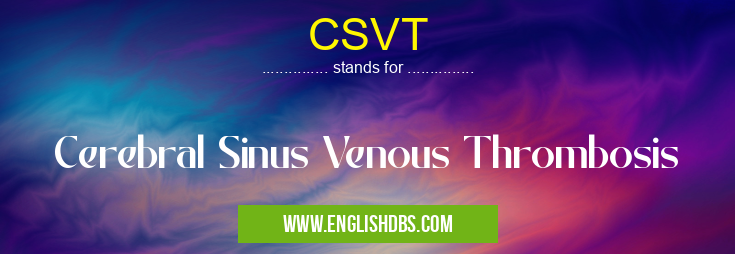What does CSVT mean in DISEASES
CSVT stands for Cerebral Sinus Venous Thrombosis, a medical condition characterized by the formation of blood clots within the sinuses and veins that drain blood from the brain. This condition can result in increased intracranial pressure and reduced blood flow to the brain.

CSVT meaning in Diseases in Medical
CSVT mostly used in an acronym Diseases in Category Medical that means Cerebral Sinus Venous Thrombosis
Shorthand: CSVT,
Full Form: Cerebral Sinus Venous Thrombosis
For more information of "Cerebral Sinus Venous Thrombosis", see the section below.
Introduction: Cerebral Sinus Venous Thrombosis (CSVT)
Causes of CSVT
- Hereditary blood clotting disorders
- Head and neck injuries
- Infections
- Sepsis
- Hormonal therapy
- Pregnancy and postpartum period
- Medications, such as oral contraceptives
Symptoms of CSVT
- Headache
- Nausea and vomiting
- Seizures
- Stroke-like symptoms
- Altered mental status
Diagnosis of CSVT
Diagnosis typically involves:
- Physical examination
- Imaging tests, such as MRI or CT scan with venography
- Blood tests to check for clotting disorders
Treatment of CSVT
Treatment options include:
- Anticoagulants to prevent further clot formation
- Thrombolysis to dissolve existing clots
- Endovascular therapy to remove clots
- Supportive care to manage symptoms
Complications of CSVT
If left untreated, CSVT can lead to:
- Stroke
- Brain hemorrhage
- Increased intracranial pressure
- Death
Essential Questions and Answers on Cerebral Sinus Venous Thrombosis in "MEDICAL»DISEASES"
What is Cerebral Sinus Venous Thrombosis (CSVT)?
CSVT is a rare but potentially life-threatening condition that occurs when a blood clot forms in one or more of the major veins that drain blood from the brain. These veins are called the cerebral sinuses. When a blood clot blocks a cerebral sinus, it can prevent blood from draining from the brain, leading to increased pressure inside the skull.
What are the symptoms of CSVT?
Symptoms of CSVT can vary depending on the location and size of the blood clot. Common symptoms include:
- Headache that is severe or worsens over time
- Nausea and vomiting
- Seizures
- Weakness or numbness on one side of the body
- Vision problems
- Speech difficulty
What causes CSVT?
CSVT can be caused by a variety of factors, including:
- Head injury
- Infection
- Blood clotting disorders
- Certain medications, such as birth control pills and hormone replacement therapy
- Pregnancy
- Cancer
How is CSVT diagnosed?
CSVT is diagnosed with a combination of tests, including:
- Physical examination
- Imaging tests, such as MRI or CT scan
- Blood tests
How is CSVT treated?
The goal of treatment for CSVT is to reduce pressure inside the skull and prevent further blood clots from forming. Treatment may include:
- Medications to break up blood clots
- Surgery to remove the blood clot
- Supportive care, such as pain medication and fluids
Final Words: CSVT is a serious medical condition that requires prompt diagnosis and treatment. Understanding the causes, symptoms, and treatment options can help individuals at risk recognize and address this condition effectively. Early intervention is crucial to prevent potential complications and improve patient outcomes.
